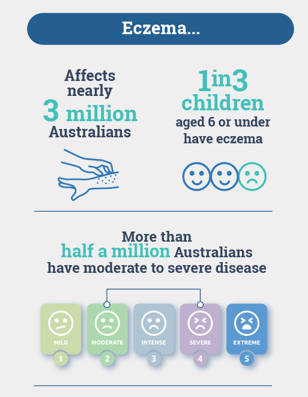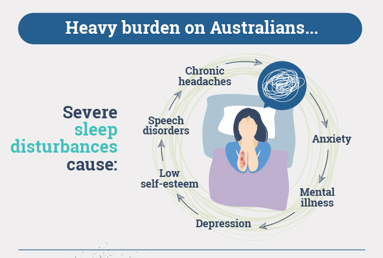
Why eczema, why now?
Every day around 2.8 million Australians, many of them young children, are directly impacted by the itch, inflammation and discomfort of eczema. Countless more are indirectly affected. Effective treatment options are available, yet poor disease control remains common, driven by complex and costly regimens, conflicting advice, myths and misconceptions, particularly regarding topical corticosteroids.
The Quality Use of Medicines Alliance has worked with consumers and health professionals to explore the barriers currently impacting eczema care in Australia and have designed a new national education program to help navigate management.
Eczema (atopic dermatitis) is a common, often life-long condition that disrupts the integrity of the skin barrier.1,2 It is characterised by inflamed, rough and discoloured skin that is itchy, painful and prone to infection.1,3 Although the exact cause is not fully understood, genetic, environmental, and immunological factors are all thought to be contributors.1,3 There is a strong link to other atopic conditions such as asthma, allergic rhinitis and food allergies.4

Data from a 2020 analysis of 494 Australian general practices – the setting where eczema is most often managed – estimated a lifetime prevalence of just over 16%.5 One in five of this cohort were classified as having moderate-to-severe eczema.
However, these figures may be an underestimate, particularly within younger cohorts. In a 2023 analysis of four Australian cohort studies, active or current eczema was reported for 16.7%–26.6% of children under 6 years of age and a history of eczema (ever-had) was recorded for 28.8%–35.6%.6
Extrapolations made based on these analyses indicate as many as 2.8 million Australians may currently have eczema and that the condition is moderate to severe for more than half a million.
Dr Kate Annear, Sydney GP and Medical Adviser, Medcast.
Beyond the barrier
The impact of eczema on individuals and their families is substantial. Beyond the physical symptoms, eczema also brings psychosocial burdens that reduce well-being and quality of life.7–9
For many people, the constant itching and pain causes sleep disturbance. Moreover, with eczema often first presenting in infancy or childhood, the effects of sleepless nights are also experienced by parents and other family members.10,11 Having disturbed sleep over a prolonged time is well recognised to negatively affect day-to-day functioning, work and study performance, and mental health.7,12
effects of sleepless nights are also experienced by parents and other family members.10,11 Having disturbed sleep over a prolonged time is well recognised to negatively affect day-to-day functioning, work and study performance, and mental health.7,12
Children with eczema are reported to have a higher likelihood of mood disturbances, inattention and learning difficulties at school than children without eczema.10,13,14 Adults with eczema have an increased risk of mental health disorders such as anxiety and depression when compared to adults without the disease.15,16
Eczema can also impose significant financial burdens on patients and their families. In one survey of Australian patients and caregivers, 75% of respondents reported significant financial impacts due to the demands of eczema.17 Prescription medications, over-the-counter treatments and specialised skincare products are all common expenses incurred as part of everyday management of eczema. These financial burdens can be exacerbated in more severe cases where specialist consultations and systemic therapies may be required, or where geography impacts access to timely care.
In their recent Burden of Eczema report, Eczema Support Australia outlined the significant cost of the disease to the Australian healthcare system as more than $593 million in 2019-2020.7 Out-of-pocket costs to individuals and families amounted to a substantial $336 million.
Building a solid foundation of care
Eczema management involves a stepwise approach, starting with foundational skin care including the use of regular moisturisers and the avoidance of known triggers, irritants and allergens, if possible.1,2,9,18,19 The use of prescription medicines, predominantly topical corticosteroids, to reduce the skin inflammation of active lesions, is also consistently recommended by both Australian and international guidelines.1,3,9,19–23
The goal of these first-line strategies is to reach a balance where symptoms are under control, the impact of treatment on daily life is minimal and side effects are absent or minimal.24
However, reaching this balance can take time for both the patient and their health professionals. Current guidance is limited and not consistent when it comes to defining what ‘regular’ moisturising might look like, or how topical corticosteroid should be applied and on what body areas. In addition, choice of products is extensive and potentially expensive based on volumes required weekly.
Tailoring first-line treatment choices is key to reducing regimen complexity and optimising this foundation of care. Primary care providers play a critical role in understanding a patient’s needs and the many factors that might influence treatment choice and ability to successfully maintain self-care.
Addressing myths and misconceptions
Despite the availability of effective treatment options, misconceptions and inconsistent information, particularly regarding topical corticosteroids, have been shown to reduce patient adherence to recommended regimens and result in suboptimal outcomes.25–28
These misconceptions and inconsistencies are further compounded by poor eczema health literacy. For example, in the 2018 PEEK study, Australian adults with eczema identified significant gaps in their knowledge and understanding of their condition.29 Of concern, 75% of respondents indicated they used the internet rather than their health professional as the main source of information about their condition.
This reliance on online content, and in particular social media personalities, has been confirmed by our own formative research for this program and represents a notable barrier to the appropriate use of topical corticosteroids to treat and manage active eczema flares.
Dr Li-Chuen Wong, Dermatologist, Head of Dermatology Department, Children’s Hospital, Westmead | Clinical Senior Lecturer, The University of Sydney | Chair, NSW Faculty of the Australasian College of Dermatologists.
A national program approach
Person-centred management is at the centre of the eczema program from the Quality Use of Medicines Alliance. To achieve this, we have combined extensive formative research with a robust co-design process that included people with lived experience of eczema and health professionals from multiple disciplines – to better understand the barriers and enablers that currently impact eczema care in Australia.
Working with consumers and medical experts, we have developed a range of education activities and resources to improve management and outcomes for people living with eczema.
Key features of our program include virtual educational visiting, webinars and peer-group learning activities, podcasts and videos. To support decision-making and empower self-care management by patients and their carers, a suite of clinical practice and consumer resources will also be available.
To find out more visit QHub.
Image credit: Eczema infographics reproduced with permission from Eczema Support Australia, 2024. Full infographic can be viewed here
This clinical update is brought to you by Medcast and the Quality Use of Medicines Alliance.

For more free Quality Use of Medicines education, check out QHUB on Medcast
View References
1. Goh MS, Yun JS, Su JC. MJA Management of atopic dermatitis: a narrative review. Med J Aust. 2022;216(11). Accessed November 3, 2023. https://www.mja.com.au/journal/2022/216/11/management-atopic-dermatitis-narrative-review
2. Therapeutic Guidelines Limited. Principles of dermatitis management. Dermatitis. Published August 2022. Accessed October 2, 2023. https://tgldcdp.tg.org.au/viewTopic?etgAccess=true&guidelinePage=Dermatology&topicfile=c_DMG_Principles-of-dermatitis-management_topic_1&guidelinename=auto§ionId=c_DMG_Principles-of-dermatitis-management_topic_1#c_DMG_Principles-of-dermatitis-management_topic_1
3. Therapeutic Guidelines Limited. Atopic dermatitis. Dermatitis. Published August 2022. Accessed September 28, 2023. https://tgldcdp.tg.org.au/viewTopic?etgAccess=true&guidelinePage=Dermatology&topicfile=c_DMG_Atopic-dermatitis_topic_1&guidelinename=auto§ionId=c_DMG_Atopic-dermatitis_topic_1#c_DMG_Atopic-dermatitis_topic_1
4. Langan SM, Irvine AD, Weidinger S. Atopic dermatitis. The Lancet. 2020;396(10247):345-360. doi:10.1016/S0140-6736(20)31286-1
5. Chidwick K, Busingye D, Pollack A, et al. Prevalence, incidence and management of atopic dermatitis in Australian general practice using routinely collected data from MedicineInsight. Australas J Dermatol. 2020;61(3):e319-e327. doi:10.1111/ajd.13268
6. Zeleke BM, Lowe AJ, Dharmage SC, et al. Epidemiology of eczema in South-Eastern Australia. Australas J Dermatol. 2023;64(1):e41-e50. doi:10.1111/ajd.13966
7. Eczema Support Australia. The Burden of Eczema - Evidence for a National Strategy. Published online 2023. Accessed November 18, 2023. www.eczemasupport.org.au/wp-content/uploads/2023/08/The-Burden-of-Eczema-Evidence-for-a-National-Strategy.pdf
8. Capozza K, Funk M, Hering M, et al. Patients’ and Caregivers’ Experiences With Atopic Dermatitis-Related Burden, Medical Care, and Treatments in 8 Countries. J Allergy Clin Immunol Pract. 2023;11(1):264-273.e1. doi:10.1016/j.jaip.2022.10.032
9. Smith S, Baker C, Gebauer K, et al. Atopic dermatitis in adults: An Australian management consensus. Australas J Dermatol. 2020;61(1):23-32. doi:10.1111/ajd.13124
10. Kern C, Wan J, LeWinn KZ, et al. Association of Atopic Dermatitis and Mental Health Outcomes Across Childhood: A Longitudinal Cohort Study. JAMA Dermatol. 2021;157(10):1200-1208. doi:10.1001/jamadermatol.2021.2657
11. Ramirez FD, Chen S, Langan SM, et al. Assessment of Sleep Disturbances and Exhaustion in Mothers of Children With Atopic Dermatitis. JAMA Dermatol. 2019;155(5):556-563. doi:10.1001/jamadermatol.2018.5641
12. Bawany F, Northcott CA, Beck LA, Pigeon WR. Sleep Disturbances and Atopic Dermatitis: Relationships, Methods for Assessment, and Therapies. J Allergy Clin Immunol Pract. 2021;9(4):1488-1500. doi:10.1016/j.jaip.2020.12.007
13. Hawkins C. The effects of eczema on children and their families: a review. Paediatr Nurs. 2005;17(6):35-39.
14. Wan J, Mitra N, Hooper SR, Hoffstad OJ, Margolis DJ. Association of Atopic Dermatitis Severity With Learning Disability in Children. JAMA Dermatol. 2021;157(6):651-657. doi:10.1001/jamadermatol.2021.0008
15. Henderson AD, Adesanya E, Mulick A, et al. Common mental health disorders in adults with inflammatory skin conditions: nationwide population-based matched cohort studies in the UK. BMC Med. 2023;21(1):285. doi:10.1186/s12916-023-02948-x
16. Ali FR, Vyas J, Finlay AY. Counting the Burden: Atopic Dermatitis and Health-related Quality of Life. Acta Derm Venereol. 2020;100(12):5766. doi:10.2340/00015555-3511
17. Capozza K, Funk M, Hering M, et al. Patients’ and Caregivers’ Experiences With Atopic Dermatitis-Related Burden, Medical Care, and Treatments in 8 Countries. J Allergy Clin Immunol Pract. 2023;11(1):264-273.e1. doi:10.1016/j.jaip.2022.10.032
18. Ross G. Treatments for atopic dermatitis. Aust Prescr. 2023;46(1). doi:10.18773/austprescr.2023.002
19. The Royal Children’s Hospital Melbourne. Eczema: Clinical Practice Guidelines. Published April 2020. https://www.rch.org.au/clinicalguide/guideline_index/eczema/
20. Therapeutic Guidelines. Considerations in the use of topical corticosteroids. Published August 2022. Accessed September 28, 2023. https://tgldcdp.tg.org.au/viewTopic?etgAccess=true&guidelinePage=Dermatology&topicfile=c_DMG_Considerations-in-the-use-of-topical-corticosteroids_topic_1&guidelinename=auto§ionId=c_DMG_Considerations-in-the-use-of-topical-corticosteroids_topic_1#c_DMG_Considerations-in-the-use-of-topical-corticosteroids_topic_1
21. Telethon Kids Institute. National Healthy Skin Guideline For the Diagnosis, Treatment and Prevention of Skin Infections for Aboriginal & Torres Strait Islander Children Annd Communities in Australia.; 2023.
22. AAD Guidelines of Care for the Management of Atopic Dermatitis in Adults with Topical Therapies Supplement.pdf.
23. Halewijn KF van, Lahnstein T, Bohnen AM, et al. Recommendations for emollients, bathing and topical corticosteroids for the treatment of atopic dermatitis: a systematic review of guidelines. Eur J Dermatol. 2022;32(1):113-123. doi:10.1684/ejd.2022.4197
24. The Australasian College of Dermatologists. Consensus Statement: Management of Atopic Dermatitis in Adults. Australiasian College of Dermatologists; 2021. https://www.dermcoll.edu.au/wp-content/uploads/2021/05/ACD-Consensus-Statement-Management-of-Atopic-dermatitis-in-adults-March-2021.pdf
25. Capozza K, Schwartz A. Does it work and is it safe? Parents’ perspectives on adherence to medication for atopic dermatitis. Pediatr Dermatol. 2020;37(1):58-61. doi:10.1111/pde.13991
26. Hon KL, Tsang YCK, Pong NH, et al. Correlations among steroid fear, acceptability, usage frequency, quality of life and disease severity in childhood eczema. J Dermatol Treat. 2015;26(5):418-425. doi:10.3109/09546634.2015.1025030
27. Eicher L, Knop M, Aszodi N, Senner S, French LE, Wollenberg A. A systematic review of factors influencing treatment adherence in chronic inflammatory skin disease - strategies for optimizing treatment outcome. J Eur Acad Dermatol Venereol JEADV. 2019;33(12):2253-2263. doi:10.1111/jdv.15913
28. Sokolova A, Smith SD. Factors contributing to poor treatment outcomes in childhood atopic dermatitis. Australas J Dermatol. 2015;56(4):252-257. doi:10.1111/ajd.12331
29. International Centre for Community-Driven Research. Atopic Dermatitis Australian Study.; 2018. https://www.cc-dr.org/wp-content/uploads/2018/05/2018AUADE_FULL-REPORT.pdf

The Quality Use of Medicines Alliance is a unique consortium of health sector organisations representing quality use of medicines expertise, education providers, researchers, colleges, peak bodies, member-based organisations, and consumer groups. Funded by the Australian Government under the Quality Use of Diagnostics, Therapeutics and Pathology (QUDTP) Program.
With one in three young Australians experiencing a mental health condition each year, and suicide remaining the leading cause of death for 16 to 24-year-olds, the way clinicians approach antidepressant use in teens and young adults has never been more important.
Discover practical strategies for GPs to identify and manage anxiety and depression in adolescents, balancing non-pharmacological care with thoughtful, evidence-based prescribing when needed. Find out how the Quality Use of Medicines Alliance is helping health professionals navigate this complex area with new clinical tools, national education programs and expert-led insights.
Wearables with PPG or ECG capabilities can identify episodes of irregular heart rhythms suggestive of AF, but should not replace traditional methods of diagnosis, such as a 12-lead ECG. Evidence of accuracy and positive predictive values from prospective, comparative trials involving older populations are limited, and the potential for inconclusive results remains a concern based on current trial findings. Their utility may be highest for symptomatic individuals or those at risk of developing AF.

